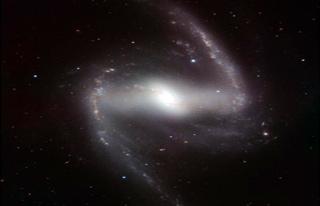
The above image taken with the powerful HAWK-I infrared camera on ESO's Very Large Telescope at Paranal Observatory in Chile, shows NGC 1365. Photo by ESO/P. Grosb�l.
WASHINGTON (BNS): ESO's (European Southern Observatory) Very Large Telescope recently captured the beautiful spiral galaxy NGC 1365 in infrared light with the help of powerful HAWK-I camera, at Paranal Observatory in Chile.
NGC 1365, also known as the Great Barred Spiral Galaxy, is a barred spiral galaxy about 56 million light-years away in the constellation Fornax. The core is an oval shape and the spiral arms extend in a curve north and south from the ends of the east-west bar and form an almost ring like Z-shaped halo.
The galaxy is an excellent laboratory for astronomers to study how spiral galaxies form and evolve.
The new infrared images from HAWK-I are less affected by the dust that obscures parts of the galaxy than images in visible light and they reveal very clearly the glow from vast numbers of stars in both the bar and the spiral arms.
According to the ESO news report, these data were acquired to help astronomers understand the complex flow of material within the galaxy and how it affects the reservoirs of gas from which new stars can form.
The huge bar disturbs the shape of the gravitational field of the galaxy and this leads to regions where gas is compressed and star formation is triggered. Many huge young star clusters trace out the main spiral arms and each contains hundreds or thousands of bright young stars that are less than ten million years old.
The galaxy is too remote for single stars to be seen in this image and most of the tiny clumps visible in the picture are really star clusters. Over the whole galaxy, stars are forming at a rate of about three times the mass of our Sun per year.
While the bar of the galaxy consists mainly of older stars long past their prime, many new stars are born in stellar nurseries of gas and dust in the inner spiral close to the nucleus. The bar also funnels gas and dust gravitationally into the very centre of the galaxy, where astronomers have found evidence for the presence of a super-massive black hole, well hidden among myriads of intensely bright new stars, the report concluded.
NGC 1365 and other galaxies of its type have come to more prominence in recent years with new observations indicating that the Milky Way could also be a barred spiral galaxy.
 Previous Article
Previous Article Next Article
Next Article











The Indian Air Force, in its flight trials evaluation report submitted before the Defence Ministry l..
view articleAn insight into the Medium Multi-Role Combat Aircraft competition...
view articleSky enthusiasts can now spot the International Space Station (ISS) commanded by Indian-American astr..
view article